What is harassment? Harassment is a type of discrimination that involves unwanted, unwelcome or...
Microaggression In the Workplace Training
What is microaggression?
Microaggression is a term used to describe the everyday verbal, nonverbal, and environmental slights, snubs, or insults, whether intentional or unintentional, that communicate hostile, derogatory, or negative messages to target persons based solely upon their marginalized group membership.
In other words, microaggressions are the little things that can make life harder and more stressful for people who are already marginalized. They might seem small, but they can have a big impact on someone's mental and emotional well-being.
Microaggressions can be intentional or unintentional. They can be said or done with malicious intent, but often they're the result of unconscious bias or ignorance. Either way, they can be hurtful and harmful.
Examples of microaggressions
Microaggressions can take many different forms, but they all have one thing in common: they communicate some form of discrimination or negativity towards a marginalized group of people.
Here are some examples of microaggressions:
-Assuming that all members of a particular group are the same
-Making assumptions about someone's gender, sexual orientation, or race
-Asking intrusive or personal questions about someone's background
-Using offensive or derogatory language
-Making assumptions about someone's abilities or intelligence
-Failing to acknowledge or recognize the achievements of members of a marginalized group
-Treating members of a marginalized group as if they are invisible
-Excluding or isolating members of a marginalized group
The effects of microaggressions
Microaggressions may seem like small things, but they can have a big impact on the people who experience them. Over time, the cumulative effect of microaggressions can lead to feelings of isolation, anxiety, depression, and anger.
Microaggressions can also take a toll on someone's physical health. Studies have shown that the stress caused by microaggressions can lead to high blood pressure, heart disease, and other health problems.
How to avoid microaggressions:
The best way to avoid microaggressions is to be aware of your own biases and assumptions. Check in with yourself regularly to make sure that you're not unintentionally discriminating against someone.
When it comes to talking about sensitive topics, always take the time to listen and learn. Don't make assumptions about someone's experiences or beliefs.
What is Microaggression Training?
Microaggression training is a type of educational program that is designed to raise awareness about the impact of microaggressions and to provide skills for preventing and addressing them.
Microaggression training programs are typically led by facilitators who have experience working with marginalized groups. The goals of microaggression training include increasing participants' self-awareness, empathy, and understanding of the impact of microaggressions.
Microaggression training programs can be tailored to the needs of specific groups or organizations. For example, there are programs designed specifically for employees of color, women, LGBTQIA+ individuals, and people with disabilities.
What to expect from Microaggression Training?
Microaggression training programs typically involve a mix of didactic instruction and interactive exercises. The goal is to create a safe and supportive environment where participants feel comfortable sharing their experiences and exploring the impact of microaggressions.
Facilitators will often use real-life examples to illustrate the concepts being discussed. Participants will also have opportunities to practice identifying microaggressions and responding to them in a constructive way.
At the end of a microaggression training program, participants should have a better understanding of the impact of microaggressions and the skills to prevent and address them.
Microaggression in the Workplace Training Online
Course overview:
This course is designed to increase your awareness of microaggressions and how they can impact the workplace. You will learn about different types of microaggressions, their effects, and how to create a more inclusive environment at work.
Course objectives:
By the end of this course, you will be able to:
- Define microaggression and give examples of common types of microaggressions
- Explain the impact that microaggressions can have on individuals and the workplace
- Recognize your own biases and assumptions
- Communicate effectively about sensitive topics
- Take action to reduce microaggressions in the workplace
Who Should Take This Course?
This course is designed for anyone who wants to learn more about microaggressions and how to create a more inclusive workplace. Whether you’re an employee, supervisor, or HR professional, this course will give you the tools you need to make your workplace more welcoming for everyone.
Module 1: Introduction to Microaggressions
In this module, you will learn about microaggressions and some of the different types that exist. You’ll also explore why they can be harmful and what impact they can have on individuals and the workplace.
Module 2: The Impact of Microaggressions
This module will help you understand the impact that microaggressions can have on people. You’ll learn about the different ways they can affect someone’s mental and physical health, as well as their work performance.
Module 3: Recognizing Microaggressions
In this module, you will learn how to recognize microaggressions. You’ll explore your own biases and assumptions, and learn how to identify microaggressions in others.
Module 4: Responding to Microaggressions
In this module, you will learn how to effectively respond to microaggressions. You’ll explore different strategies for handling them in the moment, as well as how to address them with the person who committed the microaggression.
Module 5: Creating an Inclusive Workplace
This module will help you create a more inclusive workplace. You’ll learn about different policies and practices that can reduce microaggressions, and you’ll develop an action plan to make your workplace more welcoming for everyone.
Glossary:
Workplace microaggressions: subtle, often unconscious slights or insults directed at members of a marginalized group
Inclusive: welcoming and respectful of all people
Bias: a judgment or opinion formed without adequate evidence
Assumption: a belief that something is true without any proof
Workplace culture: the shared values, beliefs, and behaviors that characterize a workplace
Sexual harassment: unwelcome sexual advances, requests for sexual favors, and other verbal or physical conduct of a sexual nature that create a hostile or offensive work environment
Racism: discrimination or prejudice based on race
Ageism: discrimination or prejudice based on age
Gender identity: the gender with which a person identifies, as opposed to the gender they were assigned at birth
transgender: a person whose gender identity does not match the gender they were assigned at birth
Please note that this is just a sample course outline and that other topics may be covered in order to meet the objectives of the course.
Own Unconscious bias: judgments that people make about others without realizing it.
Prejudice: preconceived judgments or attitudes toward other people, based on factors such as race, ethnicity, religion, or national origin.
Discrimination: unfair treatment of someone based on prejudice or stereotypes.
Microaggressions: subtle slights or insults directed at members
Racial bias: judgments about people based on their race.
Ethnic bias: judgments about people based on their ethnicity.
Religious bias: judgments about people based on their religion.
Nationality bias: judgments about people based on their nationality.
Sexual harassment: unwelcome sexual advances, requests for sexual favors, and other verbal or physical conduct
Implicit bias: judgments that people make without realizing it.
Stereotype: a fixed, oversimplified idea or image of a particular type of person.
Cognitive bias: judgments that people make based on their own beliefs and experiences.
Affective bias: judgments that people make based on their emotions.
Respectful workplace: a workplace where people feel respected and valued.
Positive change: making a difference in the workplace by promoting inclusion and reducing bias.
Action plan: a plan of action to achieve a goal.
Policies: rules or guidelines that are put in place to promote a certain behavior.
Practices: actions that are done regularly, often as part of a routine.
Hostile work environment: a work environment that is intimidating, offensive, or oppressive.
Experiencing microaggressions: feeling the effect of microaggressions, even if you don’t witness them firsthand.
Bystander effect: the tendency to do nothing when you witness someone else being harassed or discriminated against.
Engage in social justice: take action to promote fairness and equality.
Respond effectively to microaggressions: take action to address microaggressions when they occur.
Create a respectful workplace: take action to create a workplace where everyone feels respected and valued.
Change the culture: take action to change the workplace culture to one that is more inclusive.
Microaggressive behavior: any action or comment that is subtly disrespectful, offensive, or discriminatory.
Actions you can take:
1. Speak up when you witness microaggressions.
2. Challenge assumptions and stereotypes.
3. Educate yourself and others about unconscious bias and its impact on the workplace.
4. Be an ally to those who experience bias and discrimination.
5. Advocate for policies and practices that promote inclusion and respect.
6. Take action to change the workplace culture to one that is more inclusive.



